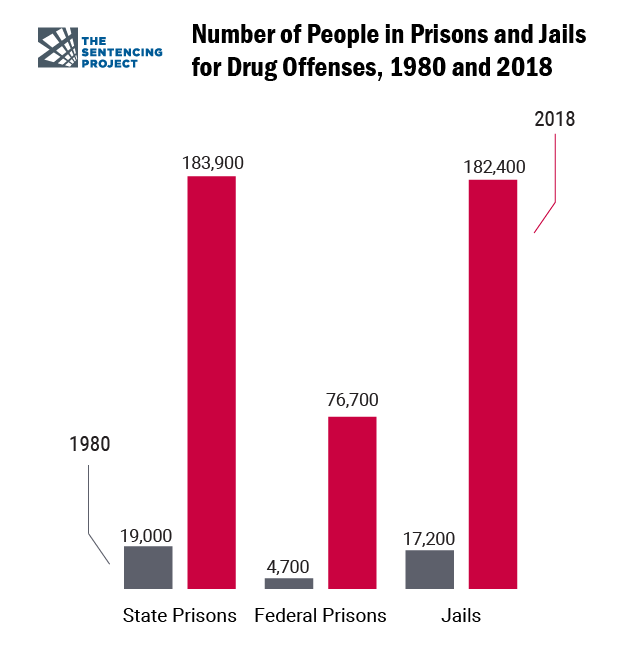Southwest Center for Equal Justice
MASS INCARCERATION
The United States is the world’s leader in incarceration.
"There are 2.2 million people in the nation’s prisons and jails—a 500% increase over the last 40 years. Changes in law and policy, not changes in crime rates, explain most of this increase. The results are overcrowding in prisons and fiscal burdens on states, despite increasing evidence that large-scale incarceration is not an effective means of achieving public safety."
https://www.sentencingproject.org/criminal-justice-facts/
Arizona has the 5th Highest Rate of Incarceration Among the States
With 559 out of every 100 thousand people in Arizona in custody, Arizona has the 5th highest incarceration rate in the US, and the highest incarceration rate in the Southwest.
In order from highest to lowest, the 4 southwest states rank as follows:
Arizona-559/100k (US-5)
Nevada- 445/100k (US-11)
New Mexico- 331/100k (US-30)
Utah- 208/100k (US- 44)
Texas, Colorado and California-parts of which are considered the southwest have the following statewide incarceration rates:
Texas-549/100k (US-6)
Colorado- 353/100k (US-27)
California- 21/100k (US- 32)

Mass Incarceration: The Whole Pie 2020
https://www.prisonpolicy.org/reports/pie2020.html
Mass incarceration starts with arrest.
In Arizona the decision to make a "full custody booking" or issue a citation and summons for an alleged misdemeanor offense is entirely within the discretion of the arresting officers. An arrest is mandatory when a felony is committed in the officer's presence.
The use of "citation release" for misdemeanors reduces mass incarceration in a number of ways. A 2007 study of Flagstaff, Arizona police practices discovered the following.
"Between June 1, 2005 and May 31, 2006 the Flagstaff Police Department effectuated 7,973 adult arrests. 1,679 of the arrests were for felony offenses and 6,253 were for misdemeanor offenses. Pursuant to departmental policy and statutory mandates 95.7% of all felony arrests were custodial and the arrestee was booked into jail. Of the 6,253 misdemeanor arrests, 26.04% were cited and released while 73.96% were booked into jail."
Source: White, W., Analysis of Flagstaff Police Department Cite and Release Policy and Practices: Impact on Local Jail Population (Flagstaff, AZ, 2007- unpublished paper)
Once arrested, release conditions whether based on an initial "bond schedule," imposed by a judge at the initial appearance or at a subsequent hearing determine who stays in jail and who is released pending trial.
Most individuals incarcerated in local jails, have not been found guilty of any crime. They are held pending adjudication.
Who Is Locked Up Before Trial?
"Six out of 10 people in U.S. jails—nearly a half million individuals on any given day—are awaiting trial. People who have not been found guilty of the charges against them account for 95% of all jail population growth between 2000-2014."
https://www.bjs.gov/content/pub/pdf/ji16.pdf
Cited by the Pre-Trial Institute at:
https://www.pretrial.org/get-involved/learn-more/why-we-need-pretrial-reform/
The practice of incarcerating people before they are found guilty is one relied upon by prosecutors to coerce guilty pleas in return for sooner release thereby avoiding the work involved in going to trial and assuring prosecutorial victory.
"Plea bargaining would be an acceptable way to resolve criminal cases if it were a fair fight between prosecution and defense. But it’s not. Since roughly the 1970s and the accompanying War on Drugs, prosecutors have been handed — and in many cases lobbied for — increasingly punitive tools to pressure defendants to take bad deals. These tools include:
Pretrial detention to separate defendants from family, jobs, and community"
Mass Incarceration Has a Disparate Impact on People of Color
"RACIAL DISPARITIES More than 60% of the people in prison today are people of color. Black men are six times as likely to be incarcerated as white men and Hispanic men are 2.7 times as likely. For black men in their thirties, about 1 in every 12 is in prison or jail on any given day."
Source: Carson, E.A. (2020). "Prisoners in 2018" Washington, DC: Bureau of Justice Statistics.
The higest incarceration rate is amongst blacks at 592 per 100k. The second highest rate is amongst American Indians/Alaskan Natives with an incarceration rate of 401. For non-Hispanic whites the rate is 187 and for Hispanics it is 182.
Source Zeng, Z., "Jail Inmates in 2018" (2020) Washington DC: Bureau of Justice Statistics
In the southwest, incarceration rates of Native Americans off-reservation are significant.
The Benefit to the Prosecution of Keeping a Defendant in Custody
Prosecutors also know that pre-trial detention is closely correlated with higher conviction rates, even when a case does go to trial. In-custody defendants are less able to assist in their own defense, present less positively to a judge or jury and have reduced community and family supports-all factors contributing to the determination of guilt, and any sentence imposed.
"People are also more likely to be acquitted if they pay bail, in part because they are less likely to take plea deals just to get out of jail. Being released before trial closely correlates with a not-guilty verdict, suggesting that the system is not punishing the most guilty, but rather the people who cannot afford to pay for their release. One study suggests that those people are “over three times more likely to be sentenced to prison” and “over four times more likely to be sentenced to jail” than those who are not detained pretrial. Similarly, a study from Columbia Law School found “significant evidence of a correlation between pretrial detention and both conviction and recidivism.”
Source: Matthews, J and Curiel, F, Human Rights Magazine "Criminal Justice Debt Problems" V44, No.3 American Bar Association
